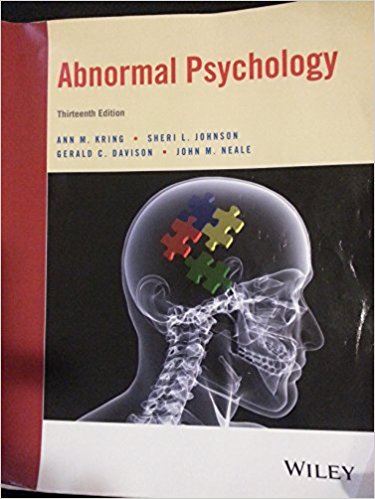Test Bank For Abnormal psychology the science and treatment of psychological disorders 13 th edition kring
Digital item No Waiting Time Instant DownloadISBN-10: 1119211018 ISBN-13: 978-1119211013
In Stock
Original price was: $55.00.$35.00Current price is: $35.00.
Test Bank For Abnormal psychology the science and treatment of psychological disorders 13th edition kring
Chapter 03: Diagnosis and Assessment
Multiple Choice
1. Diagnostic systems allow clinicians and scientists to:
a) conduct psychotherapy.
b) communicate accurately with one another about cases and research.
c) understand the role of cultural bias.
d) all of the above.
Ans: b
Type: Factual
Section ref: Introduction
Difficulty: Easy
Learning Objectives: Describe the purposes of diagnosis and assessment.
Bloomcode: Knowledge
2. Having a diagnosis provides clinicians with information about all of the following EXCEPT:
a) rates.
b) causes.
c) treatment protocols.
d) stigma.
Ans: d
Type: Factual
Section ref: Introduction
Difficultly: Medium
Learning Objectives: Describe the purposes of diagnosis and assessment.
Bloomcode: Knowledge
3. One would expect items on a depression assessment measure to have
a) interrater reliability.
b) alternate-form reliability.
c) internal consistency reliability.
d) external reliability.
Ans: c
Type: Factual
Section ref: Cornerstones of Diagnosis and Assessment
Difficulty: Medium
Learning Objectives: Describe the purposes of diagnosis and assessment.
Bloomcode: Analysis
4. If Shaniqua wants to be sure her bathroom scale has test-retest reliability, she should
a) weigh herself today and then eat a lot; get on the scale again and see if her weight changes.
b) get on and off the scale repeatedly and see if it shows the same weight each time.
c) ask others to weight themselves later that day.
d) buy a second scale and see if they both give her the same weight when she steps on them.
Ans: b
Type: Applied
Section ref: Cornerstones of Diagnosis and Assessment
Difficulty: Medium
Learning Objectives: Describe the purposes of diagnosis and assessment.
Bloomcode: Application
5. If Jose wants to know if the scale he uses to weigh his tomatoes at the grocery store has alternate-form reliability, he could
a) take them home and weigh them again in an hour.
b) weigh the tomatoes on two other scales in the produce department and see if they weighed the same.
c) ask another shopper what she thinks the tomatoes weigh.
d) take the tomatoes and put them on and off the scale several times and see if they weigh the same each time.
Ans: b
Type: Applied
Section ref: Cornerstones of Diagnosis and Assessment
Difficulty: Medium
Learning Objectives: Describe the purposes of diagnosis and assessment.
Bloomcode: Application
6. An example of a test that has predictive validity is
a) an eye exam.
b) a midterm exam.
c) an IQ test.
d) a preference test.
Ans: c
Type: Applied
Section ref: Cornerstones of Diagnosis and Assessment
Difficulty: Medium
Learning Objectives: Describe the purposes of diagnosis and assessment.
Bloomcode: Application
7. Jim was given an intelligence test in March and readministered the same test one year later. His score both times was the same. This indicates that the intelligence test has
a) high test-retest reliability.
b) high interrater agreement.
c) internal consistency.
d) none of the above.
Ans: a
Type: Applied
Section ref: Cornerstones of Diagnosis and Assessment
Difficulty: Medium
Learning Objectives: Describe the purposes of diagnosis and assessment.
Bloomcode: Application
8. Generally, it is impossible for measures to be
a) reliable but not valid.
b) valid but not reliable.
c) neither reliable nor valid.
d) both reliable and valid.
Ans: b
Type: Factual
Section ref: Cornerstones of Diagnosis and Assessment
Difficulty: Medium
Learning Objectives: Distinguish the different types of reliability and validity.
Bloomcode: Analysis
9. Britney was taking a test to measure levels of depression. All of the items covered typical symptoms of depression. This inventory would be said to have
a) high construct validity.
b) high content validity.
c) high criterion validity.
d) high statistical validity.
Ans: b
Type: Applied
Section ref: Cornerstones of Diagnosis and Assessment
Difficulty: Medium
Learning Objectives: Distinguish the different types of reliability and validity.
Bloomcode: Application
10. Jackson appears to have social phobia. This diagnosis was made by looking at his scores on a particular measure of social fear. Scores like his in the past have been shown to be related to social phobia, and also correlated with a variety of measures of social and occupational disability associated with social phobia. The measure Jackson took would be said to have
a) high construct validity.
b) high content validity.
c) high criterion validity.
d) high statistical validity.
Ans: a
Type: Applied
Section ref: Cornerstones of Diagnosis and Assessment
Difficulty: Medium
Learning Objectives: Distinguish the different types of reliability and validity.
Bloomcode: Application


Reviews
There are no reviews yet.